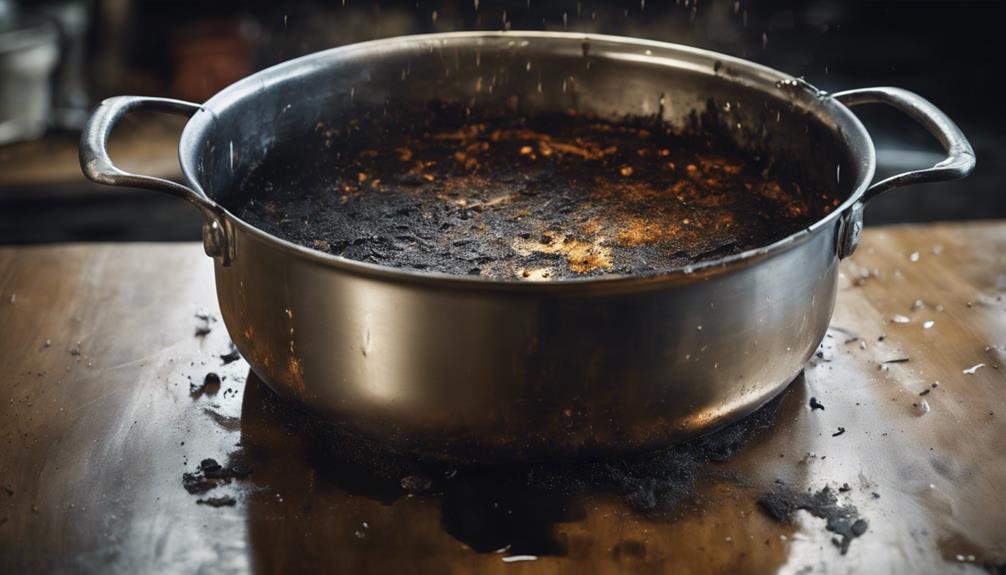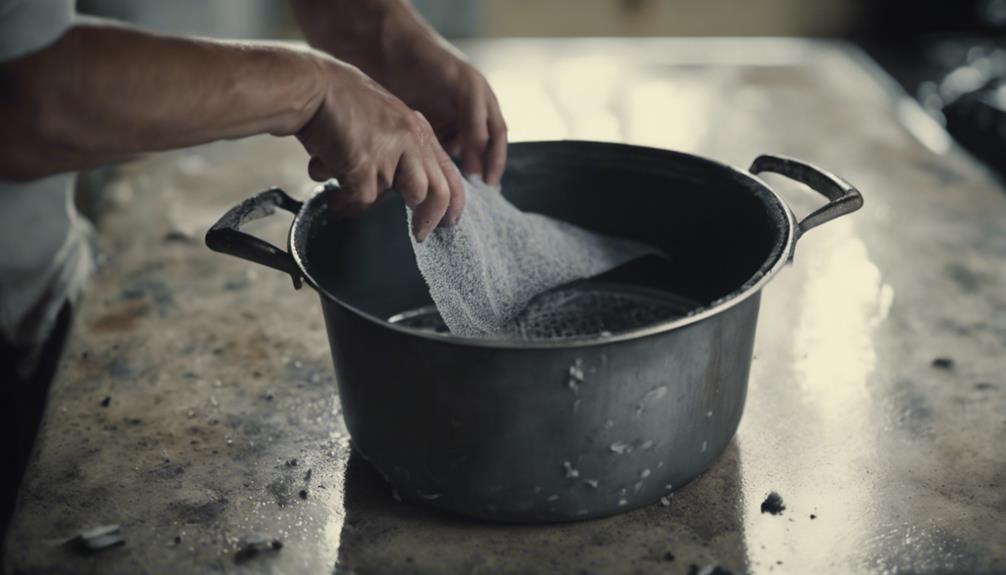To clean a burnt cooking pot, boil a mixture of vinegar and water in the pot to break down burnt-on food. Scrub with a scouring pad. Or create a baking soda paste and scrub with a nylon brush to remove burnt residue. For stainless steel pots, boil water or vinegar to loosen stuck-on food. Lemon juice and baking soda are effective for tough stains. Soak a dryer sheet in hot water and scrub to remove burnt-on food. These methods will help restore your pot to its former glory.
Vinegar and Water Solution Method
To effectively clean a burnt cooking pot, start by boiling a mixture of vinegar and water in the pot. The acidic properties of vinegar work wonders in breaking down stubborn burnt-on food particles, making them easier to remove.
Allow the vinegar and water solution to boil for a few minutes, letting the acidity do its job in loosening the burnt residue. Once the boiling is complete, grab a scouring pad or brush and begin to scrub the pot, ensuring to target the areas with the most burnt remnants.
The loosened burnt food should come off relatively easily with a bit of elbow grease. After scrubbing, rinse the pot thoroughly to wash away any remaining residue, leaving your pot clean and ready to use once again.
This method is effective in tackling even the toughest burnt-on messes, thanks to the powerful combination of vinegar's acidity and water's cleansing properties.
Baking Soda Scrubbing Technique
You can benefit from using baking soda as a gentle abrasive cleaner to tackle burnt food stains on your cooking pot. Follow the simple steps of creating a baking soda paste, letting it sit, and then scrubbing with a nylon brush or sponge.
These pot cleaning tips will help you restore your pot without harsh chemicals.
Baking Soda Benefits
For an effective way to tackle burnt-on food stains in your cooking pot, try utilizing the baking soda scrubbing technique.
Baking soda is a versatile ingredient that serves as a mild abrasive cleaner, making it ideal for removing burnt residue from pots and pans.
By creating a paste with baking soda and water, you can effectively scour away tough burnt-on food stains without damaging the surface of your cookware.
This method is particularly beneficial for stainless steel cookware, as it helps restore shine and cleanliness to the pots.
The baking soda scrubbing technique is gentle yet powerful, providing an efficient solution for dealing with stubborn burnt grime.
Incorporating baking soda into your cleaning routine on a regular basis can help maintain the cleanliness and appearance of your cooking pots, ensuring they remain in top condition for longer periods.
Scrubbing Technique Steps
When tackling burnt-on food stains in your cooking pot, the first step in the scrubbing technique involves creating a paste of baking soda and water. Apply this baking soda paste generously over the burnt area of the pot, ensuring it covers the burnt spots thoroughly.
Let the paste sit on the burnt surface for a few hours to soften and loosen the grime.
After the paste has had time to work its magic, take a nylon brush and scrub the pot vigorously, focusing your efforts on the burnt spots. The abrasive nature of the baking soda paste combined with the scrubbing action of the nylon brush helps to lift and remove the burnt-on residue effectively.
Once you've scrubbed the pot to your satisfaction, rinse it thoroughly with water to wash away the baking soda residue and reveal a clean surface underneath.
This scrubbing technique is a simple yet powerful method for tackling tough burnt-on food stains in your cooking pot.
Pot Cleaning Tips
To effectively clean a burnt cooking pot using the baking soda scrubbing technique, follow these tips for successful pot cleaning:
- Start by creating a paste of baking soda and water. This simple yet powerful solution can help restore the shine of your stainless steel pots while being gentle enough to prevent damage.
- Mix baking soda and water to form a paste that can be easily applied to the burnt areas of the pot.
- Use a soft cloth or sponge to gently scrub the burnt food residue, allowing the baking soda's mild abrasive properties to work effectively.
- Rinse the pot thoroughly after scrubbing to reveal a clean and shiny surface, free from burnt food buildup.
Deglazing for Stainless Steel Pots

Using either water or vinegar, boil the liquid in the stainless steel pot to help release burnt food particles. Deglazing stainless steel pots is an efficient and quick method to tackle stuck-on food. By boiling water or vinegar in the pot, you can loosen the burnt food particles, making it easier to scrub them off.
This process not only aids in removing the burnt residue but also restores the cleanliness of the pot. Once you have deglazed the pot, follow up with some gentle scrubbing to fully clean the surface. The boiling water or vinegar works effectively to soften the burnt food, allowing you to restore the stainless steel pot back to its original state.
Remember to rinse the pot thoroughly after deglazing and scrubbing to make sure all residue is removed. Deglazing is a simple yet efficient way to deal with burnt food on stainless steel pots, making cleaning a much easier task.
Lemon Juice and Baking Soda Method
For a natural and effective way to clean a burnt pot, consider trying the Lemon Juice and Baking Soda Method. Lemon juice, with its acidic properties, helps break down burnt food particles, while baking soda acts as a mild abrasive cleaner, making it ideal for scorched pans.
Here's why this method is a great choice for cleaning your cooking pots:
- Natural Cleaner: Lemon juice and baking soda are both natural ingredients that are safe to use in your kitchen.
- Gentle on Stainless Steel and Copper Pots: This method is gentle enough to use on stainless steel and copper pots without causing damage.
- Effective Stain Removal: The acidity of the lemon juice assists in removing tough stains, while the baking soda provides the necessary scrubbing action to lift burnt residue.
Dryer Sheet Cleaning Hack

Soaking a dryer sheet in hot water can aid in loosening burnt-on food residue from a cooking pot. The fibers in the dryer sheet act as a gentle abrasive, making it easier to scrub away stubborn burnt spots without damaging the pot's surface. This eco-friendly and cost-effective cleaning hack is simple and convenient to use.
To clean your burnt cooking pot using this method, start by filling the pot with hot water and placing a dryer sheet in it. Let it soak for some time to help loosen the burnt-on food. After soaking, use the wet dryer sheet to scrub the pot gently, focusing on areas with stubborn burnt spots. The dryer sheet's texture will assist in lifting off the residue, leaving your pot looking clean and shiny.
This hack is a great alternative to harsh chemical cleaners and requires minimal effort for effective results. Try out this simple trick next time you're faced with a burnt cooking pot.
Aluminum Foil Cleaning Trick
To effectively clean a burnt cooking pot using the aluminum foil cleaning trick, cover the burnt area with a paste of baking soda and water. This method harnesses the abrasive power of aluminum foil to scrub away stubborn burnt food residue without harming the pot's surface.
Here's how to make your pot sparkle again:
- Create a paste by mixing baking soda and water until a thick consistency forms.
- Apply the paste to the burnt area of the pot, ensuring it covers the entirety of the burnt-on food.
- Use a bunched-up ball of aluminum foil to scrub the paste into the burnt areas, focusing on tough stains to remove them effectively.
Conclusion
Now that you know these easy cleaning methods, never fear a burnt pot again. With just a few household items, you can easily restore your pots and pans to their former glory.
Remember, a burnt pot doesn't have to mean the end of the line – you can bring it back to life in no time. So next time you accidentally burn your cooking, just remember these handy tips and watch that pot shine like new.